All 79 entries tagged Coin Of The Month
No other Warwick Blogs use the tag Coin Of The Month on entries | View entries tagged Coin Of The Month at Technorati | There are no images tagged Coin Of The Month on this blog
February 09, 2024
A “Vota Publica” token of the usurper Nepotian?
Among the numerous Roman tesserae and coin-like objects that have been emerging on the market in recent years is an unusual specimen made of bronze, which can be associated to the “Vota Publica” token series (AD 305/306 – c. late fourth century) (Fig. 1). As is comparatively known, this late Roman emission consists of two clusters displaying the portrait of a Roman emperor or an Egyptian deity (Serapis, Isis, Hermanubis) on the obverse – hence they have been respectively named as “imperial” and “anonymous” series – which share a set of ritual scenes referring to different aspects of Egyptian and Isiac cults on the reverse, mostly accompanied by the legend “Vota Publica’” (= “public vows”).
On the obverse of the focused token is a bare-headed, draped, male bust facing right, with a pointed nose, a short, grape–shaped beard, and a coiffure with straight hair except for a row of curls on his forehead, which is accompanied by the legend DEO SE-RAPIDI in the dative case (“to the god Serapis”). This portrait has none of the typical features of Serapis iconography, such as a mature look, a voluminous beard, and above all a grain measure called a modius or kalathos worn as a headdress (accompanied by a radiate crown in some variants), which regularly typify the Egyptian god on the tokens from the “anonymous” group (Figs. 2-3). It should thus represent a different male figure which is not otherwise identified by the legend. On the reverse is a draped (and veiled?) female figure standing front, head turned l., holding uncertain objects in each hand, accompanied by the peculiar legend VOTA P-VBLICA. These two obverse and reverse types are unrecorded and are therefore worthy of closer examination.
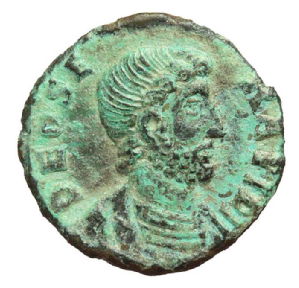 |
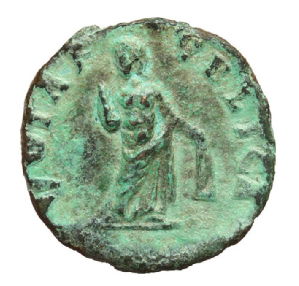 |
Figure 1: Æ “Vota Publica” token (15mm, 1.59g, 11h). Artemide Aste 19.1E, 20-21 October 2012, lot 381. Reference: L. Bricault & C. Mondello, Isis Moneta. The ‘Vota Publica’ tokens from late antique Carthage and Rome (forthcoming), cat. no. E169.1.
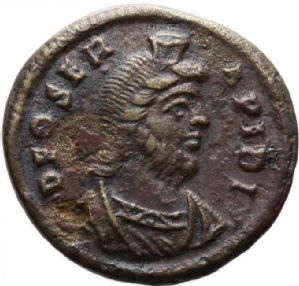 |
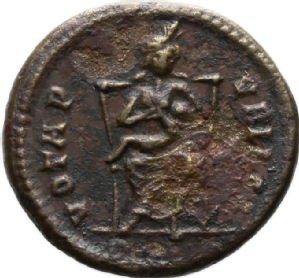 |
Figure 2: Æ “Vota Publica” token (19mm, 2.93g). Ashmolean Museum (inv. HCR71378, Douce coll.). Reference: L. Bricault & C. Mondello, Isis Moneta. The ‘Vota Publica’ tokens from late antique Carthage and Rome (forthcoming), cat. no. S83.1.
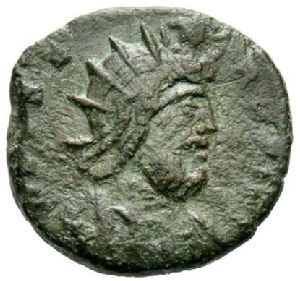 |
 |
Figure 3: Fig. 3: Æ “Vota Publica” token (18mm, 2.52g). Gorny & Mosch 278, 21.04.2021, lot 3851. L. Bricault & C. Mondello, Isis Moneta. The ‘Vota Publica’ tokens from late antique Carthage and Rome (forthcoming), cat. no. S86.3.
The specimen, with a module of 15mm and a weight of 1.59g, was offered for sale in an online auction about ten years ago but remained unsold. In the relevant auction catalogue, the token was given as a very rare (genuine) piece (“RRR”). As for the imagery, the commentator identified the obverse portrait as the emperor Julian (AD 361-63) and described the female figure on the reverse as Isis, holding a sistrum in her right hand and situla in her left (sic). Nevertheless, this description does not appear to be supported by the evidence provided by the official coinage nor by the obverse and reverse depictions occurring on the surviving “Vota Publica” tokens.
Julian’s portrait as Augustus (AD 361-363) is commonly figured on coins in the guise of a draped and double–pearl diademed bust, with a mostly long and pointed beard, either wearing military clothing or consular garb; with such features it also recurs in some of the “Vota Publica” token issues, where the ruler is clearly identified by the legend D N FL CL IVLI-ANVS P F AVG or FL CL IVLIA-NVS P F AVG. Inspired by the Greek philosopher’s model, the short or long-bearded portrait of the last ruler of the Constantinian dynasty constituted a “revolutionary” innovation with respect to the iconographic tradition of the new clean–shaven portrait of the emperor in late antiquity which was established by Constantine I (AD 306-337). However, the Julian-type portrait of the Julian type failed to prevail over the Constantinian imperial portrait model which, inspired by Augustan and Trajanic imagery, was later followed by most emperors in the West and East across the fourth and fifth centuries.
Although the male portrait in Fig. 1 is also bearded as in the case of Julian, its general features do not match the latter’s coin portraiture. Closer parallels can instead be found in the coin images of another fourth-century bearded ruler, the usurper Nepotian.Son of Virius Nepotianus and of Eutropia (half-sister of Constantine I), seemingly born after the dynastic purge by the sons of Constantine I in the summer of AD 337, Nepotian was hailed emperor by a mob on 3 June 350 after the revolt of Magnentius, and ruled the city of Rome as usurper for twenty-eight days, before being killed by his rival Magnentius’ magister officiorum Marcellinus. As a usurper, he struck coins in his own name (as well as in the name of Constantius II), the production of which was limited to the Roman mint and only consisted of two denominations, that is solidi and large billon AEs. On the two “Urbs Roma” and “Gloria Romanorum” series, the portrait of Nepotian occurs either bare-headed or rosette-diademed, with an oblong face shape, a peculiar hooked nose, a short beard, and curly or straight hair with a mostly wavy fringe.
As can be seen in Figs. 4 and 5, the vultus of Nepotian and general features of his coin portrait seemingly have some affinities with the bearded bust on the obverse of the focused “Vota Publica” token.* If this assumption is correct, such a relation may suggest that the former inspired or served as a model for the latter, although it must be said that there are some slight differences which are probably due to a different engraving style. On the other hand, in this author’s opinion, no remarkable parallels can be found with the few bearded portraits of the emperors or usurpers of the West and East on coins issued since the post-Tetrarchic period (e.g., Martinian, Vetranius, Procopius, Eugenius, Maximus of Hispania, Joannes), nor with those on Roman medallions and “contorniates” from the fourth and fifth centuries AD.
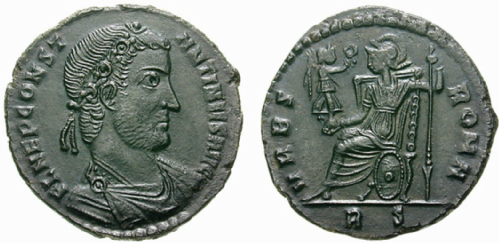 |
Figure 4: Large Æ2 (c. 24mm, 5.36g), usurper Nepotian (AD 350), “Urbs Roma” series (= RIC VIII, Rome 203).
|
|
Figure 5: Large Æ2 (5.05g), usurper Nepotian (AD 350), “Gloria Romanorum” series (= RIC VIII, Rome 200). Numismatik Lanz München, Auction 100, 20.11.2000, lot 581.
As for the reverse, the overall scheme of the type showing a female figure standing front in Fig. 1 is reminiscent of Isis’ common depiction, standing with her body supported on one leg, while brandishing a sistrum (a percussion musical instrument associated with her cult) or a palm branch in her right hand and a situla (a bucket for holy water), sometimes replaced by a patera (a libation bowl), in her left (e.g. Fig. 3). However, the draped figure on the token cannot be identified with the Isis as she lacks a basileion and other attributes which typify the goddess. The objects held by the figure remain difficult to decipher, which could maybe be interpreted as a branch of a not recognizable tree or plant in her right hand and a strip of drapery in her left. Therefore, this precludes to enlighten the precise nature of the reverse motif. Looking at the types belonging to the reverse figurative repertoire of the “Vota Publica” series, the female figure in question appears to be conceptually closer to the depictions of auxiliaries and participants in (Isiac?) religious ceremonies (e.g. torch and candelabra holders, canephores, female attendants, and devotees) (e.g. Fig. 6) than to those of the goddess Isis.
 |
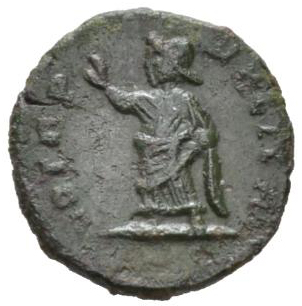 |
Figure 6: Fig. 6: Æ “Vota Publica” token (14mm, 1.41g, 12h). Naville Numismatics 12, 18.01.2015, lot 249. Reference: L. Bricault & C. Mondello, Isis Moneta. The ‘Vota Publica’ tokens from late antique Carthage and Rome (forthcoming), cat. no. I154.4.
Interestingly, this token mixes some features from the “imperial” series (= the depiction of a bust of an alleged Roman emperor or usurper on the obverse) and the “anonymous” one (= the obverse legend “Deo Serapidi”), which were both part of the “Vota Publica” token emission. As recently shown (Bricault & Mondello, forthcoming), the “imperial” series consists of a small first issue from the mint of Carthage dating back to the Second Tetrarchy (AD 305-306) and the Third Tetrarchy (AD 306-307), and a subsequent, large production from the mint of Rome struck from the reign of Constantine I (AD 313-330/331) through at least the first two generations of the Valentinian dynasty (AD 365-378). In contrast, the “anonymous” series is devoid of any chronological reference from which a reliable date can be inferred. Due to die-linkage with some of the Valentinianic groups from the “imperial” series, the “anonymous” series has commonly been regarded as a product of the Roman mint and dated to the years between AD 379-380 and 395, based on some stylistic and historical assumptions (Alföldi 1937, p. 17). However, it remains debated when the production of this undated series began and ended.
If the male portrait on the obverse of the outlined token was indeed intended to represent the usurper Nepotian or was at least borrowed from his official coinage, it may shed light on some aspects of the “anonymous” series manufacture. Among other options, one might consider the token as a trial piece or as part of a transitional group between the “imperial” and “anonymous” series by virtue of its mixed characteristics; or, it could even lead one to consider pre-dating the starting point of the “anonymous” series to AD 350.
However, in this author’s opinion, some remarks on the iconography of the specimen and its historical background may raise serious questions on its genuineness.
Not only are the types occurring on this token unattested, but even certain of their details look anomalous. Regarding the obverse, the anonymous male bust does not constitute a full copy of Nepotian’s coin portrait, as seen above. Rather, the former seems to arise from a re-working of the latter by the engraver, despite the close affinities between them. Noteworthily, the curls on the forehead of the male portrait on the token have a quite unnatural round shape, the appearance of which seems reminiscent of the rosettes forming the imperial diadem often occurring on fourth century Roman coins, including Nepotian’s Roman issues. One might imagine that the die-cutter misrepresented a rosette diadem as a sort of curly fringe when designing the obverse portrait on the token, maybe in an attempt to imitate one of Nepotian’s portraits occurring on the relevant Roman coin dies. In contrast, it seems unlikely that the curly fringe of the male bust’s hair is in fact to be understood as a rosette diadem, due to its position as jutting out on the forehead instead of being placed on the top of the head, as well as given the absence of any diadem’s ties which normally flowed down behind the ruler’s neck on coin imperial portraiture.
Moreover, the obverse of the token deviates from the epigraphic pattern attested on the extant pieces. In fact, the legend DEO SERAPIDI only accompanies the portrait of Serapis, Hermanubis, or even the jugate busts of Serapis and Isis on the obverses of the “anonymous” series, and is never combined with the portrait of a different figure.
Likewise, inconsistencies can also be found on the token’s reverse design. For instance, the right hand of the female figure and the object she bears were drawn as single whole here. As with the obverse type, this “oddity” could also result from an error or misrepresentation by the engraver, who maybe depended on one or other of the variant of Isis holding a palm branch in her right hand, as found on the reverses of the “Vota Publica” tokens. Moreover, it is worth noting that the style of both types has no parallels with any of the surviving “Vota Publica” tokens, which seem to have come out of a different workshop.
Further to these considerations on iconography and style of the token, some aspects related to its expected distribution context also need to be considered. Nepotian’s accession and death dates do not match the date and context in which the “Vota Publica” tokens were supposedly distributed, namely the imperial “public vows” pronounced annually on the 3rd January against the backdrop of the New Year’s festivals. As reported by some late antique literary sources (Descriptio consulum, Eutropius, Jerome, Socrates), Nepotian seized power on 3rd June AD 350 and held it for twenty-eight days until his death, 30 June or 1 July. Therefore, no token could have been issued in the name or with the portrait of this usurper for the public vows on 3rd January in that year or even the following year(s). After all, if one were to consider the possibility that Nepotian’s coin portrait was only used as a model for “Vota Publica” token issue struck at some point since AD 351, cui bono (“to whom is it a benefit”)?
Ultimately, the above analysis suggests that the token may be the result of a counterfeit, most likely made in modern times. Such a forgery may have resulted from the combination of genuine coin image prototypes, which were respectively taken from the Roman coinage of Nepotian (= obverse type) and the “Vota Publica” token series (= reverse type). These images were reworked by the engraver and paired with legends from the “Vota Publica” token series, in order to create an otherwise unknown specimen in an attempt to increase its market value.
We hope that a metallurgical examination of this specimen, currently held in private hands, could be conducted in the near future in order to solve this dilemma.
* Thanks are due to Dr Vincent Drost (Bibliothèque nationale de France, Département des monnaies, médailles et antiques) for suggesting a possible relation between the obverse type of the token discussed here and the coin portraits of the usurper Nepotian.
This blog was written by Cristian Mondello as part of The ‘Vota Publica’ Tokens from Late Antique Rome: Isiac and Egyptian Cults within a Christianizing Roman Empire project, which has received funding from the NRRP, Mission 4, ‘Education and Research’ – Component 2, ‘From Research to Business’ – Investment line 1.2, ‘Funding projects presented by young researchers’ (European Union – NextGenerationEU, proposal no. CFFE1C55, CUP J43C22001030001). The project is hosted at the University of Messina, Italy.
Select Bibliography
- Alföldi A., Isis-szertartások Rómában a negyedik század keresztény császárai alatt = A Festival of Isis in Rome under the Christian Emperors of the IVth Century, Budapest 1937.
- Bricault, L., & Mondello, C., Isis Moneta. The ‘Vota Publica’ Tokens from late antique Carthage and Rome. Volume 1: Catalogue, London (forthcoming).
- Burgess R.W., ‘The Date of Nepotian’s Usurpation’, Historia 72.3, 2023, pp. 370-384.
- RIC VIII = Kent, J.P.C., The Roman Imperial Coinage. The family of Constantine I. A.D. 337–364, Vol. VIII, London 1981.
May 01, 2021
A Flavian token in the Hunterian Museum, Glasgow
Writing about web page https://coins.warwick.ac.uk/token-specimens/id/hunterian.RLT24
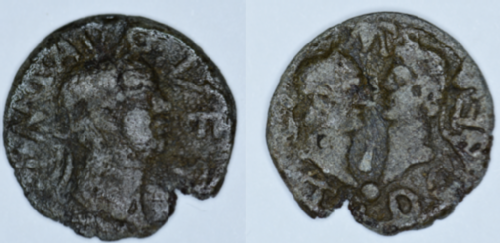
Lead token, 19mm, 12h, 2.74g. Side a: Laureate head of Vespasian right; IMP AVG VES around. Side b: Laureate heads of Titus (on left) and Domitian (on right) facing each other; IMP above and T DO CAES below.
TURS 40, The Hunterian Museum, RLT 24. Photo by author.
Amongst the Roman lead tokens now in the Hunterian Museum in Glasgow is a piece that presents the Flavian dynasty. On one side of the token we find a portrait of the emperor Vespasian, accompanied by a legend that names him. On the other side we find his sons, Titus and Domitian, facing each other with a globe between them. The token recalls coinage that was struck in Vespasian's name in AD 70 (RIC II.12 Vespasian 15–16, 37). An example of this coinage is shown below.

Silver denarius, 7.5mm, 6h, 3.22g. Obverse: Laureate head of Vespasian right, IMP CAESAR VESPASIANVS AVG around. Reverse: Bare head of Titus on left facing bare head of Domitian on right, CAESAR AVG F COS CAESAR AVG F PR around.
RIC II.12 16, American Numismatic Society 1944.100.39897.
At first glance, the coin and token are very similar: both show Vespasian on one side and his sons on the other, with accompanying legends naming the individuals shown. But upon closer examination there are also important differences. On the token both Titus and Domitian are shown wearing laurel wreaths ("laureate"); one can see the ties of the wreaths flowing down behind their respective necks. On the coin they are bare-headed. On the token a globe is placed between the busts, absent on the coin issue. This globe, and the representation of Vespasian's sons, recalls an earlier token issue showing the twin sons of Drusus the Younger, Tiberius Gemellus and Tiberius Germanicus, shown below.

Orichalcum token, 21mm, 4.67g, 12h. Obverse: Two young busts facing each other, each with a star above (the twin sons of Drusus the Younger), globe in between them. Reverse: VIIII within dotted border within wreath.
Buttrey B19/VIIII, © The Trustees of the British Museum, R. 4456.
The IMP on the token (an abbreviation of the title imperator) sits above the heads of Titus and Domitian. Who the title refers to is ambiguous; it may refer only to Titus, but since both Titus and Domitian are laureate it perhaps references both of them. Both Titus and Domitian also had the title CAESAR, abbreviated to CAES on the token and placed on the right hand side. In sum, although the token was likely inspired by the coin type, the makers did not merely copy the coin. They adapted the 'official' image and altered it; the resulting tokens were presumably given to an audience who were receptive to the alterations.
The precise occasion that motivated the creation of this token series is not known. It might have been created in connection to Vespasian's triumph (an important moment in which the new Flavian dynasty was presented to Rome), or at some later occasion. Another token issue also shows the laureate heads of Titus and Domitian, this time without the globe (TURS 41-42). On the other side of this token issue we find a horse rider carrying a spear accompanied by the legend IMP AV VES. The reference to Vespasian suggests that it is the emperor shown on horseback here. Whatever the occasion for the tokens showing laureate Titus and Domitian, their existence provides us with an insight into a particular vision of the Flavian dynasty not found on coinage or other media. This particular imagery of the imperial family would have contributed to the emotions, experiences and memories of the events in which the tokens were used.
This month's blog was written by Clare Rowan, as part of the Token Communities in the Ancient Mediterranean Project.
January 01, 2021
Glorification and personification on the Judaea Capta coinage
When Titus captured Jerusalem and destroyed the Second Temple in 70 AD, the triumph awarded to him and his father Vespasian was swathed in luxury and decadence. This was a victory that celebrated the violent result of years of strained relations between Jerusalem and Roman governance. The taking of Jerusalem involved a long and bloody siege resulting in the deaths of a reported 1.1 million people, most of whom where Jewish (Josephus, Jewish Wars 6.9.3). Those who survived were paraded through the streets of Rome, and the spoils of war contributed to the building of the iconic Flavian amphitheatre we know as the Colosseum.
The Roman victory, as so often was the case, was advertised upon the contemporary coinage. As travelling propaganda, these coins reinforced the idea of Roman supremacy and the might of the empire. The Judaea Capta type was minted in various denominations in the name of Vespasian and both of his sons, and in spite of several variations in design the overall message remained the same.
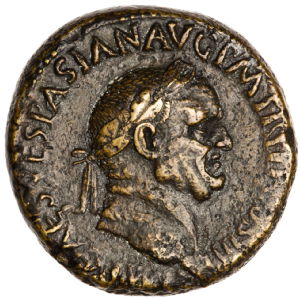 |
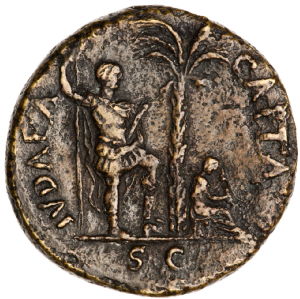 |
Sesterius of Vespasian, AD 71, RIC II.12 167, reproduced courtesy of the American Numismatic Society (inv. no.0000.999.18073).
The legend on the reverse states IVDEA CAPTA ,‘Judaea conquered’, and the coin depicts a woman seated beneath a palm tree, with a man, interpreted as the emperor, watching. The woman is Jerusalem, her hand to her cheek in a traditional expression of mourning. She is wearing civilian dress, and reflects the prophecy of Isaiah 3.26: ‘…And her gates shall lament and mourn, and she being desolate shall sit upon the ground’ (Young (1992) 170). By contrast, the male watching is standing, and still wears his armour, his foot placed on a helmet. The palm tree sets the scene of the victory in Judaea.
Personification was often used by Rome to reflect victory, as it expresses an effective message that was simple to comprehend. In this case, the use of opposing characteristics of the figures on the coins is extremely powerful in conveying the intended message. Jerusalem is depicted as female, and therefore as weak and submissive in contrast to the male figure representing Rome. The male figure, often interpreted as Vespasian himself, stands in reference to his elevated position over the woman in his victory. Where the woman is unarmed, the man is still dressed for battle in a reflection of victory
Other versions of this coin replace the armoured man with a winged Victory, or sometimes a bearded man with his hands tied behind his back. The latter is a depiction of a soldier of Jerusalem, bearded to reflect his ‘barbarian’ status in the eyes of the Roman Empire. His weapons and armour are laid down beside him in an image of defeat (RIC II.1² Vespasian 159). The legend also has variations, such as IVDAEA DEVICTA, ‘Judaea defeated’ (RIC II.1² Vespasian 1120), or DE IVDAEIS ‘[the booty] from the Judaeans’ (RIC II.12 1179) in reference to the wealth stolen from the temple of Jerusalem. The palm tree has been interpreted as a representation of Rome victorious over Judaea.
The coin is one of many examples of media expressing the Flavian victory over the province of Judaea, including the arch of Titus which still stands proudly at the entrance to the Roman forum today. In a passing glance it appears as just another Roman victory arch, but if you take a closer look you can spot iconography relating to the siege, including a parade of people carrying aloft a menorah from the temple.
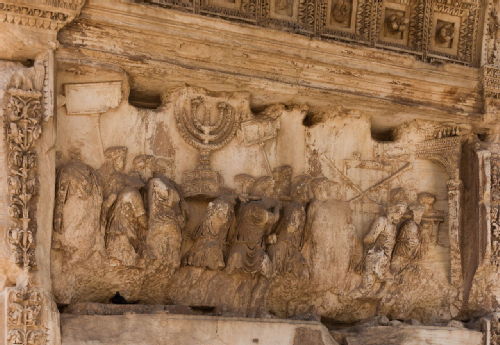
Close-up of the menorah being carried in the victory parade on the Arch of Titus .Image from WikimediaImages from Pixabay.
The Judaea Capta coinage reflects an important moment in the history of Rome, and likewise the history of Jerusalem. The Great Revolt resulted in a mass of deaths, displacement and enslavement. The minting of Judaea Capta coinage therefore becomes part of the Roman narrative of glorified victory and imperialism in the Flavian period.
 |
This month's entry was written by Rebecca Preedy. Rebecca is an Ancient History and Classical Archaeology with Study Abroad student. She is completing her final year at Warwick after a year abroad at La Sapienza. Since studying in Rome, Rebecca has been fascinated by the ancient city and is hoping to continue her studies with a postgraduate degree in Roman Material Culture.
Select Bibliography
• Josephus, The Jewish War, trans. G. Williamson (London: Penguin)
• The Holy Bible: King James Version (Massachusetts: Hendrickson 2004)
• Carradice, I. (2012) ‘Flavian Coinage’ in The Oxford Handbook of Greek and Roman Coinage ed. W.E. Metcalfe
• Claridge, A. (2010) Rome: An Oxford Archaeological Guide (Oxford: University of Oxford Press)
• Moresino-Zipper, A. (2009) ‘Die Judaea-Capta-Münze und das Motiv der Palme. Römisches Siegessymbol oder Repräsentation Judäas?’ in Jerusalem und die Länder: Ikonographie - Topographie - Theologie eds. A. Moresino-Zipper, G. Theißen, H.U. Steymans, K.M. Schmidt, S. Ostermann
• Stevenson, T.R. (2010) ‘Personifications on the coinage of Vespasian (AD 69-79)’ Acta Classica 53:181-205
• Young, E.J. (1992) The Book of Isaiah (Michigan: William B. Eerdmans Publishing Company)
September 01, 2020
The lead tokens of Roman Egypt: Thoughts on function
Based upon the work of J. G. Milne, lead tokens in Roman Egypt are thought to be an unofficial coinage. Milne came to this conclusion because, when he analysed the Roman coins from Oxyrhynchus’ rubbish dumps, he noticed that there were fewer bronze coins present for the period AD 180 – 260 (Milne 1908; Milne 1922). He thought that the lead tokens replaced the lower denomination bronze. The Oxyrhynchite tokens depicting Athena are not, however, standardised as would be expected for even a pseudo-coinage. It is also apparent that lead tokens were in use in Roman Egypt before the period AD 180 – 260, as evidenced by an example bearing the image and name of Messalina, and a series of tokens found at Abydos dating to the first century BC. Despite his awareness of these examples, Milne still took a broad-brush approach to his interpretation that tokens were low denomination coins. It is therefore worth exploring other possibilities for the ways in which tokens could have functioned in the province.
Milne’s theory regarding the use of tokens as a low denominational coinage is not totally unfounded, as there are a small quantity of tokens that indicate a denomination. These include those with the legend ‘OBOΛOI B’ (‘two obols’, see figure 2) from Tebtunis and the Serapeum at Saqqara, as well as a specimen in the Ashmolean collection with the legend ‘ΔIOB’ (‘diob[ol]’, see figure 1. It is also possible that the I is instead a Φ that has become worn. If this is the case, then the inscription cannot refer to a diobol). These are, however, in the minority in comparison to hundreds of other specimens that do not bear a denominational mark, which suggests that this was not an extensive issue of tokens. The thin flans of the examples from Tebtunis also suggest that they were impractical for everyday use, and so may not have been intended for quotidian circulation.
  |
Figure 1: Token possibly naming the denomination diobol. Obverse: Wreath, within which ΔIOB(?); solid line border. Reverse: Egyptian style altar(?); solid line border. Metal: Lead. Diameter: 26mm. Weight: 7.12g. Die axis: 12. Ashmolean Museum, Milne 5441. Image: Ashmolean Museum.
The paucity of tokens bearing a denomination, alongside the impracticality of the Tebtunis issues, suggests that another possibility is worth exploring. It is feasible that these tokens were intended to represent the given amount, without actually holding this worth or circulating as a coin. A lead token series from Rome refers to 1000 sestertii, but it seems unlikely it would have been worth that amount (TURS 1460). A modern parallel is the ‘Hell money’ used today in Asia, which while having the appearance of a banknote, exhibit denominations running into the millions. It is offered to the ancestors and not accepted as legal tender (Scott 2007, 26-28). Although these examples have a much higher denominations than on those found on the tokens from Roman Egypt, they demonstrate that a denomination does not necessarily indicate an all-purpose coin. This point is particularly pertinent as a token of the ‘OBOΛOI B’ type was found at the Serapeum of Saqqara at Memphis. When this token, and others bearing the ethnic ‘MEMΦΙC’ (Memphis), were studied by Longperier in the nineteenth century he posited that they could be religious coins used exclusively at Memphis (Longperier 1861, 411). He states that Pausanias references the use of a ‘local coin’ as a votive offering at Memphis (Pausanias Description of Greece 7.22, 3-4; Longperier 1861, 412). Pausanius implies that the coins were copper, which does obviously not fit the description of the lead tokens. The nome coinage of Roman Egypt displays imagery relevant to each of the nome districts and could perhaps fit this description, however, this was struck at Alexandria and so was ‘local’ to a questionable extent. The fact that ‘local coins’ were important for votive offering at Memphis does, however, leave open the possibility that the lead tokens fulfilled this need. A ‘coin’ created specifically as a votive offering can feasibly be encompassed within the term ‘token’.
 |
Figure 2: : Token from Tebtunis. Obverse: Apis bull facing right, with solar disc between horns, to left Isis(?) standing right wearing solar disc and to right janiform figure(?) standing left and holding uraeus serpent. Crescent and garland above in field; border of dots. Reverse: Nilus sitting left, holding cornucopia in left hand and reeds in right, Alexandria-Euthenia standing before him holding ear of corn aloft in right hand; border of dots; OBOΛOI B. Metal: Lead. Diameter: 30mm. Die axis: 12. Image: Milne 1900, pl XXVI, fig 1.
Others have posited that some of the lead tokens were tax receipts (Rostovtzeff and Prou 1900, 151-152; Mitchiner 1984). Some tokens bear the legend ΕΠ ΑΓΑΘW, which has been translated to mean ‘interest payable upon wealth’ (Mitchiner 1984, 113). However, tax receipts are known from papyrological evidence in Roman Egypt, so it seems unlikely they would take the form of tokens as well. There are also many instances in the ancient world where the phrase means ‘good fortune’, such as this inscription on a marble column drum from Lepcis Magna. The phrase is also found on rings in the Roman period (Le Blant 1896, 90; Ogden 1990, 109). Given that tokens in the ancient world are likely to have been used for euergetic distributions, this phrase would not be out of place on such tokens.
A group of tokens that are unprovenanced within Egypt can also offer an alternative function. They depict Athena on one side (unconnected to the Athena tokens from Oxyrhynchus) and have the legend ΑΓΟ (‘AGO…’, see figure 3) on the other face. It is likely that the legend refers to the agoranomoi, who oversaw markets in the Greek world. Tokens with similar legends – ΑΓ (AG…), ΑΓΟΡ (AGOR…) and ΑΓΟΡΟΝΟΜΩΝ (AGORANOMON) - have also been discovered in the Athenian agora. A possibility for their use that they were issued as proof of payment to sacrificial banquets organised by the agoranomoi (Bubelis 2013, 125). This is also plausible for Roman Egypt, as a papyrus from Karanis dating to the early third century AD also provides a link between religious banquets and their organisation by the agoranomoi (P.Mich. 8511).
 |
Figure 3: Token possibly referring to the agoranomoi. Obverse: Athena standing left, wearing Corinthian helmet, left hand resting on shield at feet to right, outstretched left hand holding Nike with wreath and palm; solid line border. Reverse: AΓO; solid line border. Metal: Lead. Diameter: 24mm. Weight: 9.98g. Die axis: 12. Köln, Institut für Altertumskunde accession no. AL_3560. Image: Köln, Institut für Altertumskunde.
The instances highlighted above are only a minority of the tokens found in Roman Egypt, however, they provide alternative suggestions for utilisation other than a low denomination coinage, and emphasise how tokens could have a variety of functions within the province.
This blog is written by Denise Wilding. The content of this blog is adapted from: Wilding, D. 2020. Tokens and Communities in the Roman Provinces: An Exploration of Egypt, Gaul and Britain. Unpublished PhD thesis, The University of Warwick.
With thanks to the Humanities Research Fund, University of Warwick for their support.
Bibliography
Blant, E. Le. 1986. 750 Inscriptions de pierres gravées inédites ou peu connues. Paris: Imprimerie Nationale.
Bubelis, W. 2013. “The Agorastikon of Hellenistic Athens: Not a Market-Tax.” Zeitschrift für papyrologie und epigraphik 185: 122–26.
Longperier, A. 1861. “Monnaies du Sérapéum de Memphis. Trouvaille de Myt-Rahinch.” Revue Numismatique VI: 1–24.
Milne, J. G. 1908. “The Leaden Token Coinage of Egypt under the Romans.” The Numismatic Chronicle and Journal of the Royal Numismatic Society 8: 287–310.
Milne, J. G. 1922. “The Coins from Oxyrhynchus.” The Journal of Egyptian Archaeology 8: 158–63.
Mitchiner, M. 1984. “Imperial Portrait Tesserae from the City of Rome and Imperial Tax Tokens from the Province of Egypt.” The Numismatic Chronicle 144: 95–114.
Ogden, J. M. 1990. “Gold Jewellery in Ptolemaic, Roman and Byzantine Egypt.” Unpublished PhD thesis, University of Durham. http://etheses.dur.ac.uk/1457/.
Pausanias, Description of Greece, trans. W. H. S. Jones. 1918. London: Heinemann.
Rostovtzeff, M., and M. Prou. 1900. Catalogue Des Plombs de l’antiquité, Du Moyen Age et Des Temps Modernes Conservés Au Département Des Médailles et Antiques de La Bibliothèque Nationale. Paris: Rollin et Feuardent.
Scott, J. L. 2007. For Gods, Ghosts and Ancestors: The Chinese Tradition of Paper Offerings. Hong Kong: Hong Kong University Press.
June 01, 2020
Frederick Parkes Weber and the Bowl of Coins Prize
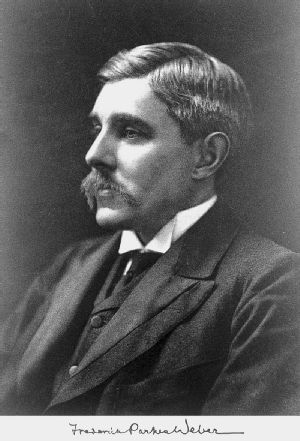 |
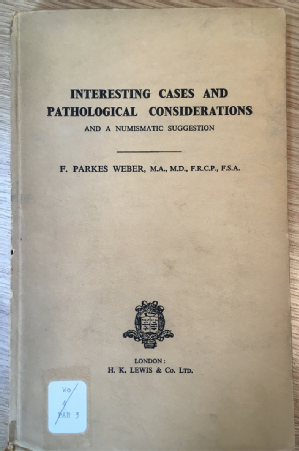 |
|
Frederick Parkes Weber,
|
Interesting Cases and Pathological
Considerations.
|
Amongst the papers of the famous dermatologist Frederick Parkes Weber now housed in the department of Coins and Medals in the British Museum is a book rather intriguingly entitled Interesting Cases and Pathological Considerations and a Numismatic Suggestion. While most of the book will not interest the student of coinage, the ‘numismatic suggestion’ appended at the end provides a great insight into Weber’s knowledge of ancient coinage (he was an avid coin collector) and the Royal Numismatic Society’s Parkes Weber Prize, currently awarded to the best essay ‘of not more than 5,000 words on any subject relating to coins, medals, medallions, tokens or paper money’ written by someone under 30.
The numismatic suggestion (photographs of the text available to read here and here) records that originally Parkes Weber proposed to the Royal Numismatic Society (RNS) an annual ‘bowl of coins’ prize. The idea came to him since, as a collector, he had to frequently quickly assess bowls of coins from various dealers across the world. The council found the suggestion impractical, and so instead implemented the prize in its current form. But it appears that Parkes Weber was not happy with the solution, and so published his original letter of 1st October 1953 to the President of the Royal Numismatic Society ‘in the hope that at some future time my suggestion will be carried out by a society of private donor. I believe that a small analogous prize is being offered to postage stamp enthusiasts with considerable success.’
Reading the letter, Parkes Weber originally proposed to the RNS an annual prize of 10 guineas to young collectors for ‘the best written diagnosis (with half an hour) of the contents of a bowl of miscellaneous coins and coin-like objects (twenty pieces in the bowl) under the supervision of a delegate of the Society in question’. He suggests they should all be good or moderately good specimens, as well as one or two imitations. He then goes on to offer detailed advice on what this ‘bowl of coins’ should contain.
Parkes Weber suggested the bowl should contain two or three counters or admission tickets (e.g. the Nürnberg Rechenpfennige, the card counters struck on the accession of Queen Victoria with the Duke of Cumberland on horseback on the reverse). He also suggests the inclusion of Greek and Roman tokens, including the so-called spintriae. These tokens carry sexual imagery on one side and a number on the other: Parkes-Weber includes the now discounted idea they were used as brothel admission tickets. He then notes that a fellow collector gave him two spintriae because the collector ‘did not like having them in his collection, when he was showing it to ladies’. Two bronze Roman tokens from the Parkes Weber collection are now in the British Museum, although only one shows an erotic scene.
 |
|
'Spintria' in the British Museum once owned by Parkes Weber.
The obverse shows a scene of sexual intercourse and the reverse
carries the number III within a wreath. © The Trustees of
the British Museum, 1906,1103.2927.
|
Parkes Weber writes that only five of the twenty coins in the bowl should be of very rare or obscure types, and suggests specific coin types for ‘occasional admission to the bowl’. These include a copper coin of the Seljukian Turks with types copied from Byzantine Christian pieces, a coin of Edessa ‘preferably a coin of Count Baldwin II with the slashing horseman reminding one of the Norman knights on the Bayeux tapestry’, a coin weight of Charles I struck by Briot, school tokens of the seventeenth century, the ‘dolphin coins’ of Olbia, medieval and modern badges, and Russian beard tokens and prison tokens. Reading the list, one is struck by the interest and knowledge Parkes Weber had of tokens from all ages.
There is, despite the publication of the letter (admittedly in a venue which may not be frequently read by numismatists) still no ‘bowl of coins’ prize. But it does make one think about what types of coins and money might make up the bowl today!
This blog was written by Clare Rowan as part of the Token Communities in the Ancient Mediterranean project.
May 01, 2020
Casting Roman tokens: Notes on two unpublished token moulds from Florence collections
Whilst the interest in token moulds has mostly been confined to excavation reports and occasional enquiries to date, recent scholarship is increasingly focusing on the value of these objects to better understand crucial aspects related to the manufacturing techniques, production location and use of tokens in antiquity (cf. Pardini et al. 2016; Rowan 2019). Lately, token moulds are also gaining attention on the market and in auction sales.
Two unpublished token moulds are presented below, which exist as part of two museum collections from Florence, Italy. Both token moulds are discussed in a study currently being undertaken by the author.
The token mould shown on Fig. 1 is held in the Museo Archeologico of Firenze (MAF) (inv. no. 79209). It is one half of a mould made of limestone, rectangular in shape, whose size is 115 x 80 x 27 mm. It would have been used in conjunction with the other half (now lost) in order to create 8 circular tokens of about 16-17mm in diameter.
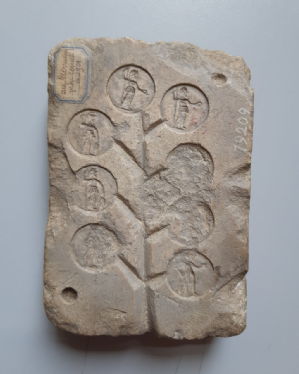 |
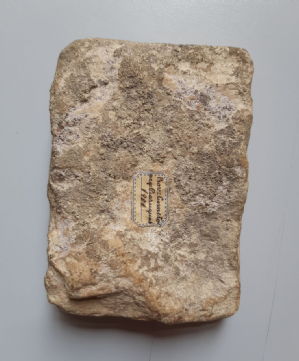 |
Figure 1: Roman token mould from Museo Archeologico Nazionale of Firenze (MAF) (inv. no. 79209) (Courtesy of the MAF).
Based on the designs engraved on the surface – but some of them are unfortunately in poor condition – the resulting tokens carried at least three different types of images: on the left side, two of the preserved designs show Mars, helmeted, in military dress, standing right, holding spear in right hand and resting left on shield on ground (the type is also applied to Minerva, who is generally portrayed with a longer robe); on the top, two token cavities depict Mars helmeted, in military dress, standing right, holding spear in right hand and patera in left hand; in the lower right corner, a token design shows Hercules standing right, holding scyphum in left hand and club in right hand. These images are variants of types commonly depicted on Roman lead tokens, as already known through the examples published by M. Rostowzew as well as on individual catalogues of museum collections (for some of the types in question, see e.g. Rostowzew and Prou 1900, 135, fig. 32; Arzone and Marinello 2019, nos. 108-111 and 113). It is noteworthy that the first of the two images of Mars mentioned above appears on the tokens produced at the time of Nero, and was adopted on official coinage just afterwards, occurring on the coins issued during the Civil Wars of AD 68-69 (Fig. 2). However, the designs attested on the MAF mould are closer to the variant of a Mars type largely found on coinage from the time of Trajan (Fig. 3) up to the fourth century, which allows us at least to date the token mould to this broad time frame. To support this, morphological and stylistic features, as well as the material used, are consistent with the token molds from Rome and Ostia, generally assigned to the period between the 1st and 3rd centuries AD.

Figure 2: Silver denarius, RIC 12 Civil Wars 20, AD 68-69. (UBS Gold & Numismatics, Auction 83, lot 183).
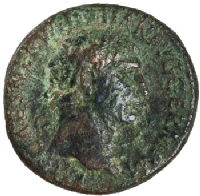 |
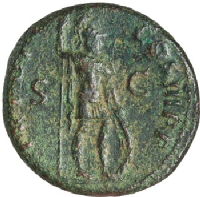 |
Figure 3: Bronze As of Trajan, Rome AD 99-100 (= RIC II, Trajan 410), American Numismatic Society (inv. no. 0000.999.18549)
This token mould is said to have been found in Corneto Tarquinia (Lazio), whose ancient site was one of the most important settlements of the twelve Etruscan cities (the ‘Dodecapolis’), and which was under Roman domination since the third century BC. This place does not appear among the sites documented as find spots of token moulds to date, which have been found in Rome and Ostia, except for two examples from Como and Telesia (Rowan 2019, 98-99). If one accepts as reliable the information on its place of discovery, this mould specimen might suggest that a local production of lead tokens existed in Tarquinia in the imperial period. Moreover, it has recently been assumed that a ‘distributed production’ rather than a centralized single workshop was the common ‘model’ for the manufacture of tokens over the Roman period, which would have been created ‘in multiple places by multiple individuals’ (cf. Rowan 2019, 97).
This piece was sold to the MAF on 10 May 1901 by the collector and member of the Accademia Colombaria Anton Domenico Pierrugues, who donated his collection of Greek and Roman coins to the museum after his death (1915).
 |
 |
Figure 4:Roman token mould from Casa Buonarroti, Florence (Lenzini Moriondo’s inventory (1964), 22/1) (Courtesy of Casa Buonarroti).
Fig. 4 illustrates one half of a token mould housed at Casa Buonarroti, whose collection was formed from the 16th to the 19th century from the bequest of Michelangelo Buonarroti and his descendants. The piece is made of limestone, quadrangular in shape, and is 83 x 76 (min. 73) x 28 mm in size. The other half of the artefact is lost also in this case. The mould would have created seven circular tokens of 14-15 mm in diameter, which were decorated with the image of the Three Graces on one side. This depiction is a popular type on Roman lead tokens. A bronze uniface Roman token (14mm, 2.90g) showing the Three Graces on one side while blank on the other side exists as part of the Casa Buonarroti collection. The iconography and size of this token perfectly match the token cavities of the mould, making it likely that the bronze tessera was cast through the mould in question (Figs. 5-6). Anyway, it is likely that this bronze token was a product of a sample casting from the mould after its discovery. This might be suggested by the absence of remains of casting sprues on the token specimen as well as by its uniface appearance, since it is highly probable that the other half of the mould containing casting branches to the cavities was also decorated (see below). However, no data is available about the place of discovery of the mould, and it is not possible to determine when precisely in modern times the tessera was cast.
 |
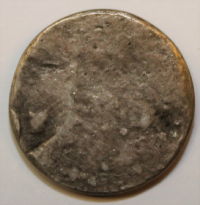 |
|
Figs. 5-6: AE Roman token (14mm, 2.90g), Casa Buonarroti, Florence.
The mould has a remarkable resemblance to a token mould of palombino marble with the same designs (105 x 75 mm for 7 circular tokens of ca. 17 mm) published by Cesano (1904, 11, fig. 1), which was found in the 19th century in Rome during the Lungotevere works. Such close ties might hint that the Casa Buonarroti mould came from Rome. According to ongoing research by the author, the mould may have been part of the inheritance of the antiquarian and senator Filippo Buonarroti (1661-1733), the great-grandnephew of Michelangelo Buonarroti, who stayed in Rome over the years ca. 1684-1699 serving as secretary, conservator of collections and librarian of the influential family of Cardinal Gasparo di Carpegna. In Rome, Filippo Buonarroti led a number of archaeological explorations which allowed him not only to assemble an impressive collection of Roman and Etruscan antiquities, but also to conduct pioneering studies in ancient iconography, epigraphy, and numismatics.
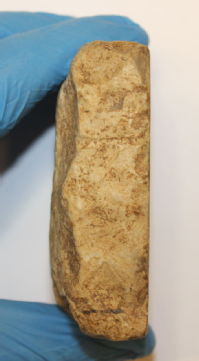 |
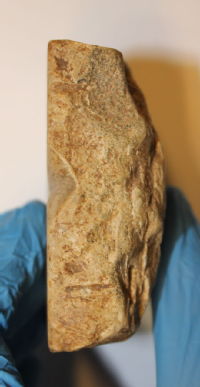 |
Figs. 7-8: Top and bottom sides of the mould from Casa Buonarroti, Florence.
Both token moulds show morphological and technical features which are largely documented for this class of objects. The extant half of the MAF mould shows a ‘herringbone’ arrangement, with a central casting channel with branches leading to the individual token moulds. The piece from Casa Buonarroti has instead only a central casting channel and no ‘branches’; one should assume that the now lost other half of the mould contained the channels through which molten lead was poured into the token cavities. In the top right and lower left corners, both molds bear the holes of the nails which were used to fasten both halves of the mould together, but also to ensure that they were correctly aligned (cf. Rowan 2019, 95). Furthermore, all four sides of the token mould from Casa Buonarroti carry small grooves which, as has been argued, would be suggestive of the use of wire which wrapped around the molds during the casting process (cf. Pardini et al. 2016) (Figs. 7-8). Also, as with a token mould from the Harvard Art Museums discussed by Rowan, a deep central hole is found in the center of each token cavity of the Casa Buonarroti mould, being visible in the guise of a protuberance on the body of one of the Graces in the resulting token, as is attested on the extant bronze tessera from Casa Buonarroti. This depression would be a clue of the method employed for engraving the token designs, since it would have been caused by the bit of a tool used for cutting the circular depressions before the designs were engraved. Finally, the back of both mold specimens is unworked, as attested on many moulds of this type.
Further analysis and the potential discovery of new specimens could help develop future discussion on the ancient token moulds, thus providing a more complete picture about the production and use of tokens in the ancient world.
 |
This blog was written by Cristian Mondello as part of The creation of tokens in late antiquity. Religious ‘tolerance’ and ‘intolerance’ in the fourth and fifth centuries AD project, which has received funding from the European Union’s Horizon 2020 research and innovation programme under the Marie Skłodowska-Curie grant agreement No 840737.
Select bibliography
A. Arzone and A. Marinello, Museo di Castelvecchio. Lead Tokens. Tessere di piombo (Modena, 2019).
L. Cesano, ‘Matrici e tessere di piombo nel Museo Nazionale Romano’, NSc. (1904), 11-17.
G. Pardini, M. Piacentini, A.C. Felici, M.L. Santarelli, and S. Santucci, ‘Matrici per tessere plumbee dalle pendici nord-orientali del Palatino. Nota Preliminare’, in A.F. Ferrandes and G. Pardini (eds), Le regole del gioco. Tracce, archeologi, racconti. Studi in onore di Clementina Panella (Rome, 2016), 649-667.
U. Procacci, La Casa Buonarroti a Firenze (Firenze, 1965).
M. Rostowzew, Tesserarum urbis Romae et suburbi (St. Peterburg, 1903).
M. Rostowzew and M. Prou, Catalogue des plombs de l’antiquité (Paris, 1900).
C. Rowan, ‘A Roman token mould in Harvard’, Coins at Warwick Blog.
C. Rowan, ‘Lead token moulds from Rome and Ostia’, in N. Crisà, M. Gkikaki, and C. Rowan (eds), Tokens. Culture, Connections, Communities (London, 2019), 95-110.
Cult Development in Provincial Syria
|
|
Introduction
I will use the above coinage to briefly explore the developments of a Syrian cult and thus the relationship between local cults and Roman (military) presence in the eastern provinces.
Pictured in fig.1 is a rare tetradrachm minted in the 3rd century AD under Caracalla. The tetradrachm may have been the principal unit of silver coinage used in Syria during this period, but the iconography on the reverse makes this coin intriguing. It is thought to depict cult statues belonging to the Temple of Ataragtis and Hadad (Syrian gods) at Hierapolis (Syria).
Cultic and Civic Context
The cult of Atargatis and Hadad was Syrian in origin and the sanctuary pre-dated Greek/Macedonian conquest. From Seleucid rule to the late third century AD Hierapolis was a provincial religious hub and mustering point for the Roman military. The Greek legend on a similar bronze coin under Severus Alexander (fig.2): ΘΕΟΙ CYRIAC IEPOΠΟΛΙΤΩΝ ‘the gods of Syria, (coin) of the Hieropolitans’ helps identify the figures represented on the Caracalla coin. Near-contemporary written accounts and artwork from Syria corroborate this.
 |
|
Fig.2 Bronze coin of Hierapolis, minted under Severus Alexander (222-235 AD).
Obverse: Radiate bust of Severus Alexander right, AYT KAI MAP AYΡ CE - ΑΛΕΞΑΝΔΡΟC [CEB].
Reverse: Image of the Syrian gods of the Hierapolitans: Hadad left, seated on throne; Atargatis right, seated on throne; ensign between them. Below lion walking right; ΘΕΟΙ CYRIAC IEPOΠΟΛΙΤΩΝ.
Photo credit: Staatliche Museen zu Berlin, Münzkabinett.
|
It seems that a variety of peoples worshipped at this sanctuary, and thus the deities were attributed a variety of names and associated myths. The Greeks called Atargatis ‘Hera’ (and Aphrodite) and Hadad ‘Zeus’. Lucian, writing in the second century AD, describes the ionic temple with its cult statues of Atargatis and Hadad sitting on their thrones borne by lions and bulls respectively, as Caracalla’s coin depicts. These specific deities are further identified by their tall headdresses and attributed objects. Both deities hold sceptres in their left hands and Atargatis holds a spindle in her right hand, as Lucian describes. It is thought that Hadad may be holding either a thunderbolt or ear of corn in his right hand.
Between the cult statues themselves was an ensign, called a ‘semeion’. Its exact nature has been disputed. Lucian writes: ‘between both of these [statues] stands another golden statue. It does not have its own shape but bears the images of the other gods’. I agree with Darcus that here Lucian is likely referring to the images of Atargatis and Hadad (or some other ‘indigenous’ gods).
Roman Military Symbols and Indigenous Gods
The near identical ensigns on the coins comprise of hollow rings on staffs. Gabled pediments top them with doves at the summits. They bear a clear resemblance to Roman military standards. Another similar standard in the same iconographical context can be seen in a relief from fellow Syrian city, Dura-Europos (fig.3). The relief depicts a specific type of military standard with cloth banners called a ‘vexillum’. Based on other archaeological evidence Dura has yielded, this vexillum type seems to have been the most common there. The same vexillum has been identified by some scholars on the coins of Caracalla and Severus.
 |
|
Fig.3 Relief from Dura-Europos,
second or third century AD.
On the left Hadad; the right Atargatis;
between them the ‘semeion’.
Photo credit: Yale University Art Gallery.
|
There is evidence that Roman military standards were housed in shrines in provincial Syria. It seems that in the imperial period these standards possessed their own spirit/sacred powers, offering protection and symbolising the strength of the Roman Empire. Ergo, they were an expression of military ideology and collective identity. The ethnic composition of the army in Syria would have been diverse, with local recruitment having been initiated the previous century. Although the extent to which the Roman military interacted with civilians in provincial Syria is uncertain, it is well known that the Roman military acted as a primary vehicle in the process of cult mobility in imperial times. Thus the cult of Atargatis itself disseminated across the empire: throughout Syria, northern Mesopotamia, the Mediterranean and even made it to Britain.
Fergus Millar noted that the absence of the ensign on earlier coins under Trajan supports the suggestion that the ensign was a later addition to the temple. If there had been a permanent Roman military standard in the temple, it was likely not the ensign Lucian saw. Instead Lucian describes a more indigenous religious ensign, very similar to motifs seen on Syrian cylinder seals dating back to the second millennia BC: staffs bearing the heads of deities with birds on top.
At the bottom of the reverse, an eagle with a lion walking below it can be seen. The exact meanings of these symbols in this context are uncertain. It is possible that this is a visual hierarchy reinforcing imperial positions, a common practice in the provinces: Rome on top, symbolised by Jupiter’s eagle and Hierapolis/Syria below, by a lion of Atargatis. However, the presence of the eagle on Syrian coinage has been traced back to before Roman conquest and on other Syrian coinage the eagle is thought to allude to local myth and history.
Commissioner and Audience?
Knowing the commissioner and audience of a coin helps greatly in attempting to identify the potential meanings of such symbols. Based on the metallurgical composition and style of the Caracalla coin, it has been suggested that it was minted in Rome but it could also have been minted in Syria. Regardless, the coinage almost certainly represents deliberate choices made by the elite, meaning that the imagery could reflect social attitudes of the inhabitants of Hierapolis, attempt to modify them, or even ignore them (although the latter is unlikely).
Additionally, without knowing the circulation of this coinage, it is difficult to say the extent to which the messages were intended for the local community and ‘outsiders’, although in most cases it was predominantly for the former. The Caracalla coin likely only circulated locally, but like many Syrian cities, the inhabitants of Hierapolis would have been culturally diverse. Furthermore, people throughout Syria and other provinces visited and sponsored the cult, so if they had seen this coinage it likely would have resonated with them too, evoking a sense of collective Syrian identity. This may have also been the case for people who were familiar with a similar image, for example the Dura relief.
As for the Roman military present in this area, would they have seen this coinage? Such locally issued silver coinage was used for army pay. Would the juxtaposing of a military standard with the Syrian gods have created a sense of collective identity and unity for soldiers and civilians? Or in this context had the traditionally Roman symbol been transformed into a distinctly local one?
Conclusion
The analysis of this coinage has shown the development of the cultic identity of Hierapolis (Syria). When a Roman military symbol was placed in the local temple context, ‘Romanness’ would have become a part, not just of the religion, but also the local myth and history surrounding the cult. Even if a Roman military standard were not housed in the temple, the desire to express it as such existed and was on public display through this coinage. Thus, Hierapolis reconciled their civic identity with the Roman presence in their society, exhibiting their place in the empire.
This month’s coin of the month was written by Nicholas Aherne. Nicholas studied Classical Civilisation at Warwick and graduated in 2019. He is planning to undertake a Masters in 2020. His current research concerns the interactions between Greco-Roman culture and indigenous cultures in the Hellenistic and Imperial Periods, with particular focus on religion.
Bibliography
Lucian, De Dea Syria, (Perseus)
Darcus, R. (1967) A new translation of Lucian’s De Dea Syria with a discussion of the cult at Hierapolis, MA thesis (Vancouver: University of British Columbia)
Strong, H.A. (1913) The Syrian Goddess: Being a translation of Lucian’s ‘De Dea Syria’ with a life of Lucian, ed. with notes and introduction by Garstang, J. (London: Constable and Company)
Pliny the Elder, Natural History, trans. John Bostock (London: Taylor and Francis : 1855) (Perseus)
Strabo, Geography, trans. H.C. Hamilton (London: George Bell & Sons: 1903) (Perseus)
Andrade, N.J. (2013) Syrian Identity in the Greco-Roman World (Cambridge: Cambridge University Press)
Billing, J. The Military Standards of the Roman Legions: Symbolic objects of ideology, veneration and belief https://www.academia.edu/8640103/The_Military_Standards_of_the_Roman_Legions_Symbolic_objects_of_ideology_veneration_and_belief
Butcher, K. (2005) ‘Information, legitimation, or self-legitimation? Popular and elite designs on the coin types of Syria’ in Coinage and Identity in the Roman Provinces eds. C. Howgego, V. Heuchert, and A. Burnett (Oxford: Oxford University Press) 143-162
Butcher, K. (2004) Coinage in Roman Syria: Northern Syria, 64 BC-AD 253 (London: Royal Numismatic Society)
Butcher, K. (2007) ‘Two Syrian Deities’, Syria 84: 277-285
Butcher, K. and Ponting, M. (1995) ‘Rome and the East: Production of Roman Provincial Silver Coinage for Caesarea in Cappadocia under Vespasian’, Oxford Journal of Archaeology 14: 63-78
Erdkamp, P. (2007) A Companion to the Roman Army (Oxford: Blackwell Publishing)
Howgego, C. (2005) ‘Coinage and Identity in the Roman Provinces’ in Coinage and Identity in the Roman Provinces eds. C. Howgego, V. Heuchert, and A. Burnett (Oxford: Oxford University Press) 1-18
James, S. (2019) The Roman military base at Dura-Europos, Syria: an archaeological visualization (Oxford: Oxford University Press)
Kaizer, T. (2013) 'Identifying the divine in the Roman Near East' in Panthée: religious transformations in the Graeco-Roman Empire eds. L. Bricualt and C. Bonnet, in Religions in the Graeco-Roman world V. 177 (Boston: Brill) 113-130
Meadows, A.R. (1998) ‘The Mars/eagle and thunderbolt gold and Ptolemaic involvement in the Second Punic War’ in Coins of Macedonia and Rome: Essays in Honour of Charles Hersh eds. A. Burnett and U. Wartenberg (London: Spink)
Price, S. (2012) ‘Religious Mobility in the Roman Empire’, The Journal of Roman Studies 102: 1-19
Weiss, P. (2005) ‘The Cities and their Money’ in Coinage and Identity in the Roman Provinces eds. C. Howgego, V. Heuchert, and A. Burnett (Oxford: Oxford University Press) 57-71
Williamson, G. (2005) ‘Aspects of Identity’ in Coinage and Identity in the Roman Provinces eds. C. Howgego, V. Heuchert, and A. Burnett (Oxford: Oxford University Press) 19-28
Wimber, K. Michelle (2007) Four Greco-Roman Era Temples of Near Eastern Fertility Goddesses: An Analysis of Architectural Tradition, MA Thesis (Provo: Brigham Young University)
January 01, 2020
A Bronze Neapolitan Coin and its Relevance to Rome
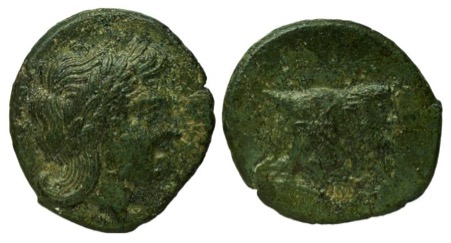
RRC 1/1, Bronze Coin minted in Neapolis (Naples), now in the Bibliothèque nationale de France, 3.03g, 17.7 mm
Obverse: Laureate head of Apollo
Reverse: A man-headed bull, with the legend ΡΩΜΑΙΩΝ (Romano).
This simple bronze coin is part of a collection of bronze and silver coinage discovered in the Naples area, dating to the late fourth century BC. It has often been described as one of the first true ‘Roman’ coins, and as such it is the first entry in Michael Crawford’s Roman Republican Coinage, the standard typology of Roman coins from this period. This is slightly misleading, given that Neapolis (modern day Naples) was not under direct Roman rule at this point and was a Greek speaking city, indeed, the legend on the coin itself is in Greek, despite making reference the Romans.
Neapolis was a fairly old city by this point, as there is evidence to suggest settlement in the Naples region as early as the first millennium BC, forming part of the great migration of Greeks from their heartlands in the east to southern Italy (Magna Graecia), Sicily and further afield in the western Mediterranean. Amongst other things, it is likely that it was the Greeks who first introduced true ‘coinage’ into Italy, in line with the discovery of coin hoards dating back to the sixth century in southern Italy. Therefore it is not surprising that the first example of coinage relating to Rome should have been discovered in a southern, Greek city. But why does the coin say ΡΩΜΑΙΩΝ ((coin) of the Romans)?
By the late fourth century BC, Rome was expanding its political reach down towards the southern end of the Italian peninsula. It was engaged in a series of wars with another Italic people, the Samnites of the south-central spine of Italy, and in this conflict many of the Greek cities of southern Italy were effectively forced to pick a side. The region of Campania, in which Neapolis was located, fell between the Romans and the Samnites and thus turned into a battleground between them. According to Livy, after a power struggle between the pro and anti-Roman factions within Neapolis, the city opened its doors to the Romans and signed a pact of alliance, the Foedus Aequissimum, with them. This is dated to around 326 BC, as the second Samnite war was getting under way, and this has also been taken as the earliest likely date for the coin being struck. It is thus possible that the use of ΡΩΜΑΙΩΝ on the coin was meant to publicise the Roman alliance to the general population, but that still does not explain the immediate reason for the coin being struck.
At this point it should be noted that the production of coinage in ancient states was generally not regularised to the same degree as in modern states. Whilst coins and notes are the predominant representation of physical wealth (and a key means of exchange) in the modern world, this was not the case in antiquity, where wealth might just as easily be represented by precious metals or even cattle; indeed it is interesting to note the similarity of the Latin term for money, pecunia, with the Indo-European root word for cattle, peku. Similarly, minted coinage was not necessarily needed for the purposes of exchange either. The Romans themselves appear to have gotten by without using minted coinage at all up until the third century BC, with small transactions seemingly conducted via the use of so called aes grave, literally rough bronze, nuggets of metal that were not shaped or minted in any fashion. Whilst in the modern world the intense quantity and velocity of financial transactions make it an imperative for central banks and mints to constantly replenish the physical money supply on a regularised basis in order to ensure liquidity, this was less the case in the ancient world where there were generally far fewer financial transactions and where the maintenance of ‘liquidity’ was not a concern of the issuers of money. Therefore, issues of ‘authorised’ coinage by cities tended to be made with a specific ‘goal’ in mind, such as to pay for public works or military campaigns, rather than to provide an easy means of conducting small scale private commerce.
The latter of these two examples provides a strong rationale for why this coin may have been minted. Given the new alliance with the Romans, Neapolis would have entered the war against the Samnites, which meant that the city would have had to pay to raise both troops and ships (for the treaty with Rome stipulated the provision of ships, naval warfare being a Roman weakness at this point) for the duration of the war. Coins represent an easy way of remunerating soldiers and sailors, as it relieves a state of the obligation to provide directly for them; if a soldier or sailor receives his dues in coins, he can use that new found wealth to pay for his own food, drink and other sundry expenses, as opposed to having that supplied by the state. Wars, in the ancient and modern eras, are often associated with large expansions of the money supply so as to pay for armies - the severe collapse of the value of Roman coinage during the ‘Crisis of the Third Century AD’ has been associated with large scale minting by various aspirants for the imperial throne in order to win and maintain the support of the soldiery. To return to Neapolis, minting this and other coins provided the city with a means to fund its obligation to the Roman alliance, which seems a sensible explanation for the profusion of Neapolitan coinage towards the end of the third century, a period of prolonged warfare in southern Italy.
This idea in turn provides an interesting link to the Roman ‘adoption’ of coinage in the third century. As Rome grew to be major power in the Italian peninsula and beyond, the amount of warfare that it engaged in inevitably increased; conflict with the Samnites in the fourth century would be followed by wars with Pyrrhus of Epirus and Carthage in the third century, wars that necessitated long military campaigns. Given that (even prior to the full professionalization of the military under Marius), the Roman state provided a stipendium to its troops, the amount paid out as part of this would likely have increased immeasurably during the long years of war in the third century, which perhaps explains why the Romans finally adopted coinage wholesale, as a utile means of providing the stipendium.
Returning to the coin itself, aside from the legend on it, the imagery is largely traditional and displays continuity with earlier Neapolitan coin issues. The bull-headed man on the reverse is a staple not just of Neapolitan coinage but of other coins of Magna Graecia, and has often been taken as a reference to the process of synoecism between Greek colonists and local Italic peoples, the bull being a traditionally Italic symbol (one later used on the coinage of Rome’s rebellious Italian allies during the Social War). On the obverse there is a depiction of the god Apollo, whom we are told by later poet Statius was among the patron gods of Neapolis, so again this is not a hugely surprising piece of imagery. It could thus be argued that the coin is representative of a fulcrum point in the history of Magna Graecia; Greek language and traditional Greek and Graeco-Italic symbolism remains on the coin, but the reference to the Romans is a clear sign of the region’s gradual absorption into the Roman sphere of influence and thus foreshadows the profound social changes that would affect both the Greek cities of the south and Rome itself in the coming century.
 |
This month’s entry was written by Ieuan Luke. Ieuan graduated from Warwick in 2017 and is still interested in the ancient world, focusing primarily on ancient economies and the reception of antiquity in Europe and Russia.
December 01, 2019
The crocodile as a symbol of Egypt on a victory coin of Augustus
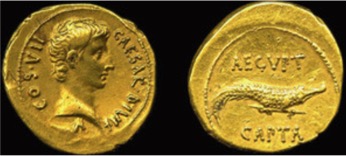 |
Gold Aureus from 27BC (RIC 12, P.86, no. 544) The obverse depicts head of Augustus with ‘CAESAR.DIVI.F.COS.VII’ inscribed. On the reverse is a crocodile facing right, representing Egypt. The reverse legend reads ‘AEGVPT CAPTA.’ Image produced courtesy of the Trustees of the British Museum.
After a tense period of civil war, Octavian’s decisive victory at the Battle of Actium in 31BC left Marc Antony with insufficient military support to win the war, and a year later Egypt was conquered and absorbed into the Roman Empire. Marc Antony and Cleopatra committed suicide, leaving Octavian as the unrivalled, sole ruler of the Roman world, a victory he was keen to advertise. The above pictured coin is a gold aureus celebrating the acquisition of Egypt. It is typical of victory coinage, with the obverse depicting a portrait bust of the ruler (who was the victor), in this case Octavian, and the reverse depicting an image symbolic of the conquered nation, in this case a crocodile. The gold aureus is similar to a near identical issue of silver denarii struck in the previous year. Both coins hailed Octavian as son of the divine Julius Caesar, establishing his legitimacy on a political and religious level.
That Octavian chose the image of a crocodile to place on the reverse of his coins is of particular interest. First and foremost, it presents Octavian as the victor over a foreign enemy. Crocodiles were popular in Roman art as images representing foreign and exotic ideals, and their use here was no doubt intended to draw attention to the war in its international context, and thus overshadow the morally dubious truth of it being, in truth, a civil war. Octavian was now the sole ruler of Rome, having violently deposed of his co-consul. It was therefore crucial for him to deter any criticism and suggestions of tyranny. The crocodile was a particularly suitable image because of its associations with danger, and thus it had the added benefit of presenting Marc Antony as a threat to Rome. This helped to authorise Octavian’s war against his fellow Roman, and once-ally, and aligns with much of Octavian’s earlier propagandist campaign against him. The crocodile therefore helps to reinforce the idea that Octavian should be hailed, not as the violent murderer of his co-consul, but as the saviour of the Roman Empire.
 |
Coin of Crassus showing a crocodile. Image produced courtesy of the Classical Numismatic Group.
This is not the first time a crocodile had been used in Roman coinage. Already in 37BC, the crocodile had appeared on the coinage of a figure largely identified as M. Licinius Crassus, son of the triumvir Crassus. It is believed that this coin celebrated Roman territory ceded to Cleopatra VII of Egypt by Marc Antony. It is interesting therefore, that this same symbol of Egypt should be used by Augustus only ten years later to celebrate the exact opposite: the conquering of Egyptian territory by Rome. On the coin of Crassus, it is likely that the crocodile was chosen because of its associations with the Nile, which itself was associated with the agricultural wealth of Egypt. We can therefore infer that this earlier use of the image of the crocodile was intended to celebrate Egypt in a gesture of diplomacy. Octavian, aware of this, may well have deliberately used this same image, already known for its associations with agricultural wealth, in order to boast of his achievement at having acquired such an important nation into the Roman Empire. Rome relied heavily on Egypt for its imports of grain, and hence Octavian’s victory was of crucial importance. It is likely the coin instilled pride in its Roman viewers, for belonging to such a large, powerful empire.
As we have seen therefore, the coin presents Octavian as a successful military leader, who not only saved, but also contributed to the Roman Empire. It also served to justify his recent war against Marc Antony by presenting it as a foreign conquest. We can see that the imagery was carefully chosen in order to secure and validate Octavian’s position as sole ruler of Rome.
 |
This month's entry was written by Richa Snell. Richa is a final year classical civilization student with an interest in material culture and iconography, which she is hoping to pursue further by studying for a master’s degree next year. She is currently writing her undergraduate dissertation on imperial uses of Egyptian imagery.
Bibliography
R.A. Gurval (1995) Actium and Augustus: The Politics and Emotions of Civil War (Ann Arbor: University of Michigan Press).
C.E. Barrett (2017) ‘Egypt in Roman Visual and Material Culture’ in Oxford Handbooks Online in Classics Studies, ed. G. Williams (Oxford; New York: Oxford University Press).
M.Swetnam-Burland (2015) Egypt in Italy: Visions of Egypt in Roman Imperial Culture (Cambridge: Cambridge University Press).
D. Vagi, Crocodiles on Roman coins familiar as the emblem of Egypt – https://www.coinworld.com/news/precious-metals/crocodiles-on-roman-coins-familiar-as-the-emblem-of-egyptian-province.html (15 Feb 2015). Accessed 31 Oct 2019.
October 01, 2019
Hortensia Sperata, Token Issuer in Rome or Ostia
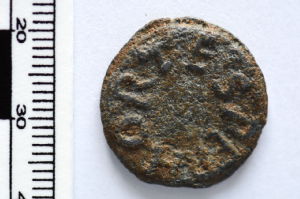 |
 |
Lead token from Rome or Ostia, now in the The Bibliothèque nationale de France in Paris (Rostowzew and Prou 422a). 12h, 20mm, 4.13g, TURS 1241.
Side A: HORTE SPER around in a circle.
Side B: Palm branch within a wreath.
Pictured above is a lead token, which, from the style of its design and its fabric, we can assign either to the city of Rome or to Ostia. What is remarkable about this piece is that the token carries the name of a Roman woman: Horte(nsia) Sper(ata). Her name circles around the edge of one side of the token in a way very similar to Roman coinage. The other side carries imagery commonly found on lead tokens in this region: a wreath and palm branch. These communicate to the user a festive, happy atmosphere.
This was not the only token that Hortensia issued. Another token carries her name in full: HORTENSIA SPERATA, with the same design (palm branch within wreath) on the other (TURS 1240). Two further tokens are smaller in diameter (13-15mm) and seem to carry an abbreviation of her name: HOR on one side and SPE or SP on the other (TURS 1242, 1243). Why would Hortensia have so many variant tokens? She might have wished to have two sizes of token (20mm and 13-15mm), with one perhaps worth more than the other, or with each representing different products or levels of access. An engraver could have created a mould for her tokens that cast both sizes at once, a practice known from other surviving examples.
 |
The palombino marble mould pictured here would have been utilised to make tokens during the Roman imperial period. It was found along with several others on the Esquiline Hill in Rome in 1882. Here we can find another individual responsible for tokens, whose name has been abbreviated to LVE (a practice also commonly found in graffiti). Like the tokens of Hortensia, we can see that LVE wanted two sizes of token: a larger and a smaller piece. On the smaller piece his initials have become ligate: i.e. they have been joined together ti fit into the reduced size. In a similar way Hortensia's name was abbreviated on her smaller tokens.
We do not know anything more about Hortensia Sperata, but one presumes she had a certain amount of wealth. From the men and women named on Roman lead tokens, some were magistrates in government or colleges; others appear to be linked to bath houses. Whatever the specific use of these tokens (and it is very hard to be certain), they were likely used in an act of patronage: the provision of necessary small change, for example, the sponsoring of a banquet or other event, or a distribution. The lead tokens of Rome and Ostia reveal a world otherwise unrecorded in our sources, where both men and women utilised these objects to cement personal relationships and consolidate local communities.
This coin of the month blog was written by Clare Rowan as part of the ERC-funded Token Communities in the Ancient Mediterranean Project.
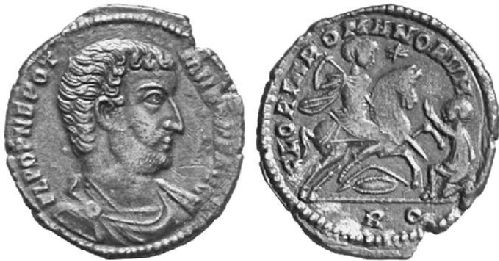
 Clare Rowan
Clare Rowan

 Please wait - comments are loading
Please wait - comments are loading
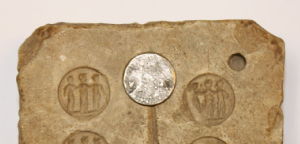
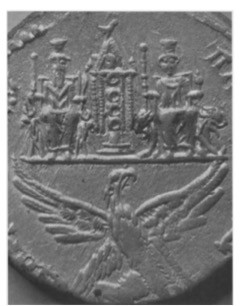

 Loading…
Loading…

